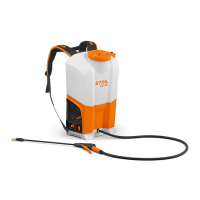0458-600-8221-A
8
English
5 IMPORTANT SAFETY INSTRUCTIONS
5.5 Handling Chemicals
WARNING
■ Chemicals can be harmful to individuals, animals and the
environment if improperly used. In addition, chemicals
that are caustic, corrosive or poisonous should not be
used in your sprayer. Carefully read the labels on
chemical containers prior to use.
■ Chemicals are classified into categories of toxicity.
Pesticides regulated by the EPA, for instance, use signal
words to indicate the product's potential to make you sick.
"Caution" appears on pesticides found to be least harmful
to humans. "Warning" indicates a product that is more
poisonous than those in the "Caution" group. Pesticides
with the signal word "Danger" on the label are very
poisonous or irritating and should be handled with
extreme care. Finally, pesticides labeled "Danger -
Poison" are for restricted use only and generally must be
used under the supervision of a certified applicator.
■ Similarly, the EPA rates herbicides with the signal words
"Caution," "Warning" and "Danger." Each category will
have unique handling characteristics. Familiarize yourself
with the characteristics for the category you are using.
■ Mix only compatible pesticides and/or herbicides. The
wrong mixture can produce toxic fumes. When handling
chemicals and when spraying, make sure you are
operating in accordance with local, state, and federal
environmental protection rules and guidelines. Do not
spray in windy conditions. To help protect the
environment, use only the recommended dosage – do not
overuse.
■ Do not eat, drink or smoke while handling chemicals or
while you are spraying. Never blow through nozzles,
valves, hoses or any other component by mouth. Always
handle chemicals in a well ventilated area while wearing
appropriate protective clothing and safety equipment. Do
not store or transport chemicals with food or medicines,
and never reuse a chemical container for any other
purpose. Do not spray materials into other containers,
especially food and/or drink containers.
■ In case of accidental contact or ingestion of chemicals, or
in case of contamination of clothing, stop work and
immediately consult the chemical manufacturer's
instructions. If in doubt as to what to do, consult a poison
control center or doctor without delay. Have the product's
label available to read to or show the person you consult.
■ Clean all chemical spills immediately. Dispose of any
residue in accordance with state or federal laws and
regulations.
■ Keep chemicals out of the reach of children and other
unauthorized persons and away from animals. When not
in use, store chemicals in a safe place. Follow the
manufacturer's recommendations for proper storage.
5.6 Sprayer
WARNING
■ To reduce the risk of electric shock:
– Do not immerse the sprayer in water or other fluids.
– Store the sprayer indoors.
■ This battery-powered sprayer is intended only for spraying
chemicals and other liquid solutions. Use for other
purposes may increase the risk of personal injury and
property damage.
– Read and follow the operating instructions in this
manual for approved applications, @ 16.
■ To reduce the risk of personal injury to the operator and
bystanders:
– Wear rubber/chemical-resistant boots
with non-slip soles. Never wear sandals,
flip-flops, open-toed or similar footwear.

